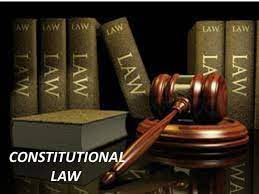Subject Code&Title: LAW2CSL Constitutional LAW
Word Count: 1500 Words Limit
Research: This is not designed to be a comprehensive research assignment, but we do expect students to undertake some additional research for this Assignment.
While we do not want to be prescriptive it will help your understanding of these issues if you locate at least 4-5 good quality sources relevant to the issues raised by the Assignment questions. The purpose of the additional sources is to help you to develop more in depth answers to the questions. You need to understand the key elements of the relevant legal principles but you are not expected to provide an original interpretation of the cases or area of law.
LAW2CSL Constitutional LAW Assessment-La Trobe University Australia.

The key criteria for your research is that your additional sources are (a)appropriate to answering the questions; (b) from authoritative sources, such as case law academic journals books and authoritative electronic sources such as the Australian Public Law blog; and (c) that you use the sources to add depth to your analysis and argument.
ACADEMIC INTEGRITY:
This Assignment should be the product of your own reading, research, thinking and writing.While you may confer with other students in LAW2CSL about general issues arising out of the Assignment eg your understandings of interpretation and the corporations power your answers in this Assignment should be solely your own work.
In order to minimise academic integrity issues when writing this Assignment, you should do the following:
- Put all direct quotes into ‘quotation marks’.
- Footnote comprehensively. This means you should footnote direct quotes and you should footnote all other instances where you have taken an idea from somewhere else, including cases, books, journal articles and electronic sources.
o Follow the AGLC rules for footnoting, including that footnote markers come AFTER the punctuation. That means here,1 and here.2 NOT here3.
o Footnotes are not included in the word count, so please keep text in the
footnotes to a minimum. Any substantive text that is placed in a footnote will not be considered in marking the Assignment. - Paraphrase comprehensively. Ideally, synthesise two or more sources for an issue into your own words. If you are paraphrasing a single source, transform the text of that source thoroughly into your own words. Text that is poorly paraphrased – eg a sentence drawn from another source that changes a small number of words while keeping the same sentence structure – is poor academic practice and may be inconsistent with academic integrity expectations.
LAW2CSL Constitutional LAW Assessment-La Trobe University Australia.

o One useful technique for developing the skill of paraphrasing is to close your source material while you’re writing your notes from that material. It forces you to think more deeply about what you’ve read, and enables you to put your own understanding into your notes, rather than just copying out what someone else has said. This technique also helps you to identify when you don’t understand something and need to read a bit more about it.
In order to minimise the risks of collusion, do not share your answers to this Assignment with any other student. You should also not engage any other person to undertake this assignment on your behalf, that is, do not engage with any contract cheating facilities.
All Assignment answers will be subject to Turn It In. Assignments that are identified as not meeting Academic Integrity expectations will be reported to the Law School’s Academic Integrity Officer for further investigation. Law students place at risk their admission to legal practice if a finding of serious academic misconduct is made against them.
LATE SUBMISSION, EXTENSIONS AND WORD LIMIT
Assignments that are submitted after the specified submission date for that Assignment will be subject to the La Trobe Assessment (Late Submission of Tasks) Policy. Please ensure you are familiar with this Policy.
Students who wish to request an extension for their Assignment should email Madelaine outlining the details of that request and attaching evidence, if any.You should request an extension as soon as you think you might need one. Students with LAPs who wish to request an extension should comply with the requirements of the LAP for their extension requests.
LAW2CSL Constitutional LAW Assessment-La Trobe University Australia.
Writing succinctly is a skill that you are developing through your University degree and you should aim to answer this Assignment within the word limit. You may exceed the word limit by up to 10% of the total word count without penalty. Where a marker suspects that an Assignment has exceeded the word limit by greater than 10%, the marker will make a good faith attempt to identify the point at which the word count exceeds the 10% leeway, and will stop reading the Assignment at that point. Any text that is included beyond this identified 10% leeway point will not count towards the final mark for the Assignment.
2.ASSESSMENT CRITERIA
This Assignment been designed with two aims. The first is to assess and deepen your understanding of the material from Weeks 1-6 of the course. You will give yourself the best chance of performing well in the Assignment if you do your reading, watch the lectures, attend tutorials and/or prepare answers to the tutorial questions, attempt the weekly Topic Questions, generate a good set of notes, and do targeted research on the relevant issues.
The second aim of the Assignment is to develop your skills in answering both short answer and essay/argument style questions in constitutional law. The Questions below are separated into short answer and essay/argument-type. Your answers in this Assignment will allow you to receive feedback on your skills with both types of question, and identify areas where you can improve both for the final exam and for the development of your legal skills
more generally.
The Assignment will be marked using the rubric and the criteria uploaded separately on the LMS.
3.ASSIGNMENT QUESTIONS
TASK: ANSWER THE QUESTIONS ABOUT THE EXTRACTS IDENTIFIED BELOW.
The extracts identified below are from the Work Choices Case (2006), which we examine in Week 5 (Grants and Corporations Powers). The instructions below direct you to answer questions about specific extracts from the judgment in Work Choices. These questions assume that you understand the factual circumstances, the key outcomes and the reasons for the decision in the Work Choices case, all of which form part of the material for Week 5.
Question 1:
Read paragraphs 183-196 of the copy of the Work Choices Case (2006) under the Assessment 2 information on the LMS page. These paragraphs are extracts from the majority judgment of Chief Justice Glees on and Justices Gummow, Hayne, Heydon and Crennan. Answer the question below.
The plaintiffs in the case argued that the interpretation of s 51(xx) should be limited in a way that would make the Work Choices legislation invalid. They made this argument on a number of grounds. In paragraph 189 of the judgment, the majority judges describe two of these grounds as: ‘arguments about social or political utility’ and arguments that ‘explicitly or implicitly invoked notions of federal balance’.
• What problems did the judges identify with both kinds of argument?
• Why did they consider these arguments to be unhelpful in constitutional
interpretation?
Question 2
Read paragraphs 526-553 of the copy of the WorkChoices Case (2006) under the Assessment 2 information on the LMS page. These paragraphs are extracts from the dissenting judgment of Justice Kirby in the case. Answer the question below.
In his dissenting judgment, Justice Kirby strongly disagrees with the majority opinion. In the extract you have been asked to read, he explains his reasoning on issues that he calls ‘testing propositions by outcomes’ (para 541) and ‘the federal issue’ (para 545).
• What reasons does Kirby J give for taking a different view to the majority in relation to constitutional interpretation on these questions?
• What does Kirby J consider will be the outcome for Australia’s federal structure of upholding the validity of the Work Choices legislation?
TASK: MAKE CONSTITUTIONAL LAW ARGUMENTS
Question 3:
Relying on your analysis above, and any other case law and secondary material that is relevant and helpful, answer the following question:
LAW2CSL Constitutional LAW Assessment-La Trobe University Australia.

The majority judgment and Kirby J’s judgment in the Work Choices case present two different approaches to constitutional interpretation. In using a range of interpretive principles and take different factors into account, the judgments illustrate how varied approaches to constitutional interpretation can lead to different outcomes. Which approach or approaches to interpretation do you prefer and why?
It will help you to answer this question if you use your answers to Questions 1 and 2 to identify principles of constitutional interpretation used in the two judgments and consider the impact of those principles on constitutional decision-making in general.
In your answer you may discuss approaches to constitutional interpretation that do not appear in the extracts you have been asked to read as long as your discussion of these approaches is directed at answering Question 3.